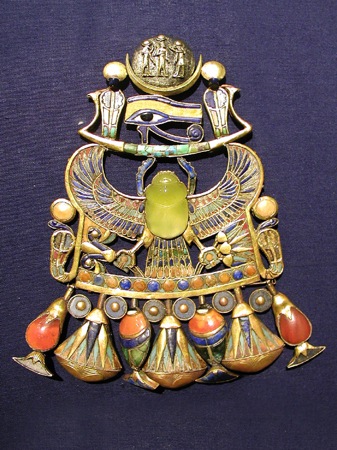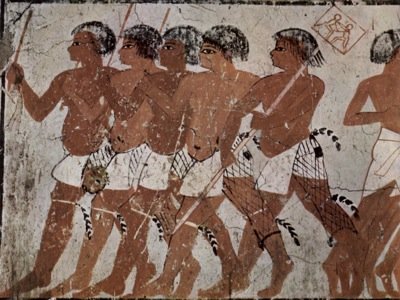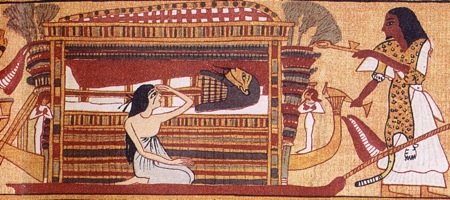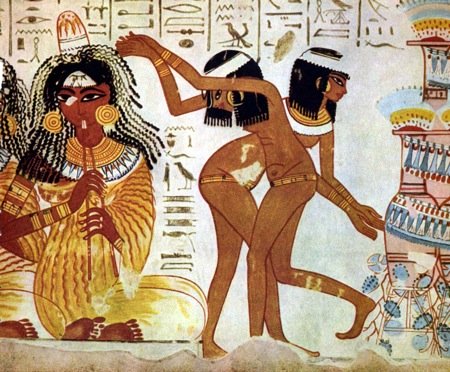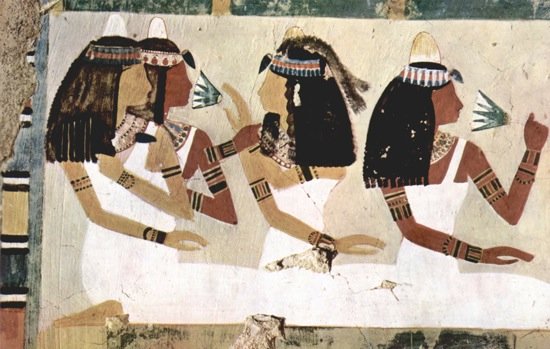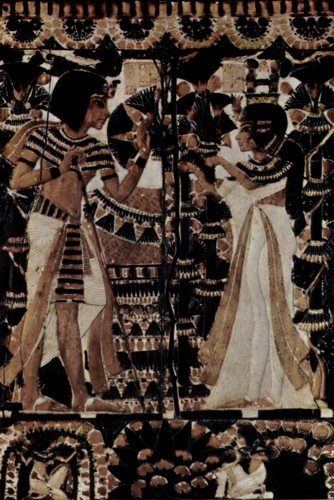|
Ancient Egyptian ClothingAncient Egyptian clothing reflected the splendor and symbolism of its culture. At a time when fabric was not cut and sewn, the Egyptians expressed themselves through draped, pleated and carefully arranged fabrics, combined with exquisite jewelry, headdresses and hairstyles. Ancient Egyptian art depicts people, from all stations in life, going about their daily business. In paintings, sculptures and sarcophagi, we see slaves building pyraminds, scribes transcribing works, Pharaohs giving orders to their deputies, and gods and goddesses welcoming the dead to the afterlife. Although the artists probably did not depict costumes with absolute fidelity, they are close enough to give us a good idea what ordinary, and extraordinary, ancient Egyptians wore.
Like most cultures, ancient Egyptians used dress to signify the wearer's social class. While most non-ceremonial garments were simple, the fabric's quality, and the jewelry worn with it, indicated where the person fit in the social pyramid. Let's examine these garments, in depth if not at length. Ancient Egyptian Men's ClothingAncient Egyptian clothing was designed for Egypt's hot and (then) humid climate. Clothing therefore became a status marker, since it was not needed to keep warm. Early Egyptian art depicts men wearing lion and leopard skins fastened about their shoulders. These were not for warmth; the Egyptians believed that the leopard's ferocity would transfer to the skin's wearer. Later on, only the most powerful members of Egyptian society wore these skins. When not topless, men wore short capes, similar to but simpler than the ancient Greek chlamys. They also wore tunic-like shirts and corselets (decorative chest armor).
Low-status men and slaves wore loincloths or a wrapped skirts sometimes called schents or skents. Foot soldiers wore short skirts, corselets and little else. These skirts were often pleated, apparently by pressing the cloth into a grooved board, the pleats held by starching the fabric. The length and style of the skirt worn tell the viewer not only much about the wearer, but also about the period when the person lived. Early men's skirts were knee-length or shorter, and fitted closely to the hips. Skirts lengthened during the Middle Kingdom period. Double-layered and pleated skirts start to appear during this time. New Kingdom skirts began to incorporate large, triangular decorative panels.
During the New Kingdom period, many new dress styles entered Egyptian society, probably as a result of contact with the near east. The calasiris, a long tunic "fringed about the legs" as Herodotus described it (The Persian Wars Even the religious hierarchy dressed in white linens. Priests generally shaved their heads, and wore a real or imitation leopard skin around their shoulders. Gods and goddesses were drawn in ordinary, ancient Egyptian clothes, but adorned in headdresses and divine symbols. Their immortality was emphasized during the New Kingdom period by their wearing fitted sheaths, in contrast to the pleated robes then in fashion. Ancient Egyptian Women's Clothing
The most common garment for ancient Egyptian women was a tubular dress, closely fitted to the body, and held up by one or two straps. This dress appears in all periods of ancient Egyptian history, and is sometimes covereded with patterned decorations. No one knows quite how these dresses were decorated––paints? dyes? leather appliques? beads?––but decorated they were. Like their counterparts, low-class Egyptian women, and female slaves, often went nude or nearly-nude, wearing short skirts or a small strip of cloth over the genitals. Some wore a calasiris-like tunic.
In ancient Egyptian clothing, modesty was not a serious concern for either sex. Women's breasts were sometimes exposed or partially exposed by their garments. Even wealthy women wore revealing garments, by today's standards. Paintings show women's bodies outlined beneath sheer, even translucent fabric. Egyptian women primarily adorned themselves through jewelry, cosmetics and elaborate headwear. Wealthy women worked hard to rid themselves of body hair, and used honey as a depilator. Materials and Construction
According to Herodotus, Egyptians, by law, could only wear linen garments and shoes "of the papyrus plant" (The Persian Wars Sandals and bare feet were the only footwear worn in ancient Egypt. The sandals were similar to what were once called thongs, i.e. a strap going over the top of the foot, attached to a rope that goes between the big and second toes down into the sole. This mixture of austerity and adornment typifies ancient Egyptian art and design. The ancient Egyptian civilization thrived, in part, because of its strict hierarchy and strong religious code. They also adapted their outfits to the climate. Related Reading: Return to Enjoy Your Style's vintage style section. Return to Enjoy Your Style's home page. Search Enjoy Your Style: |
Search this site:





